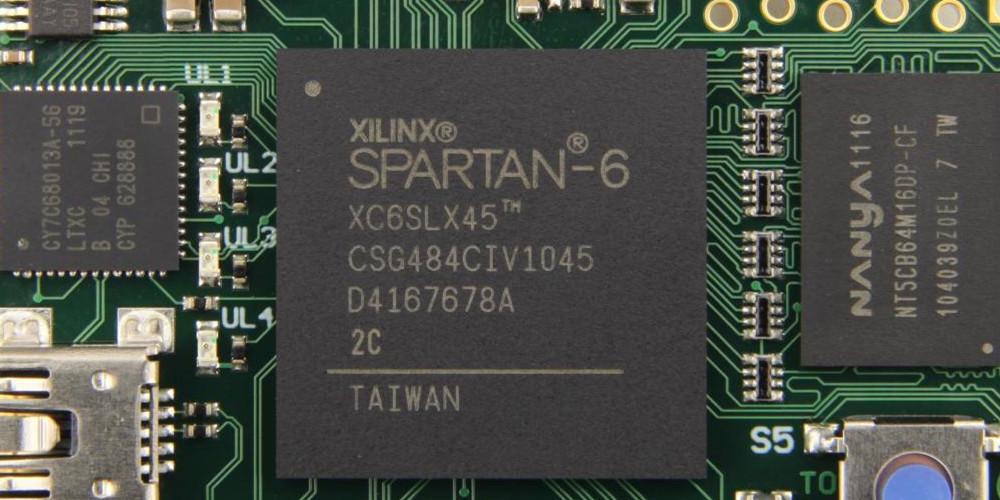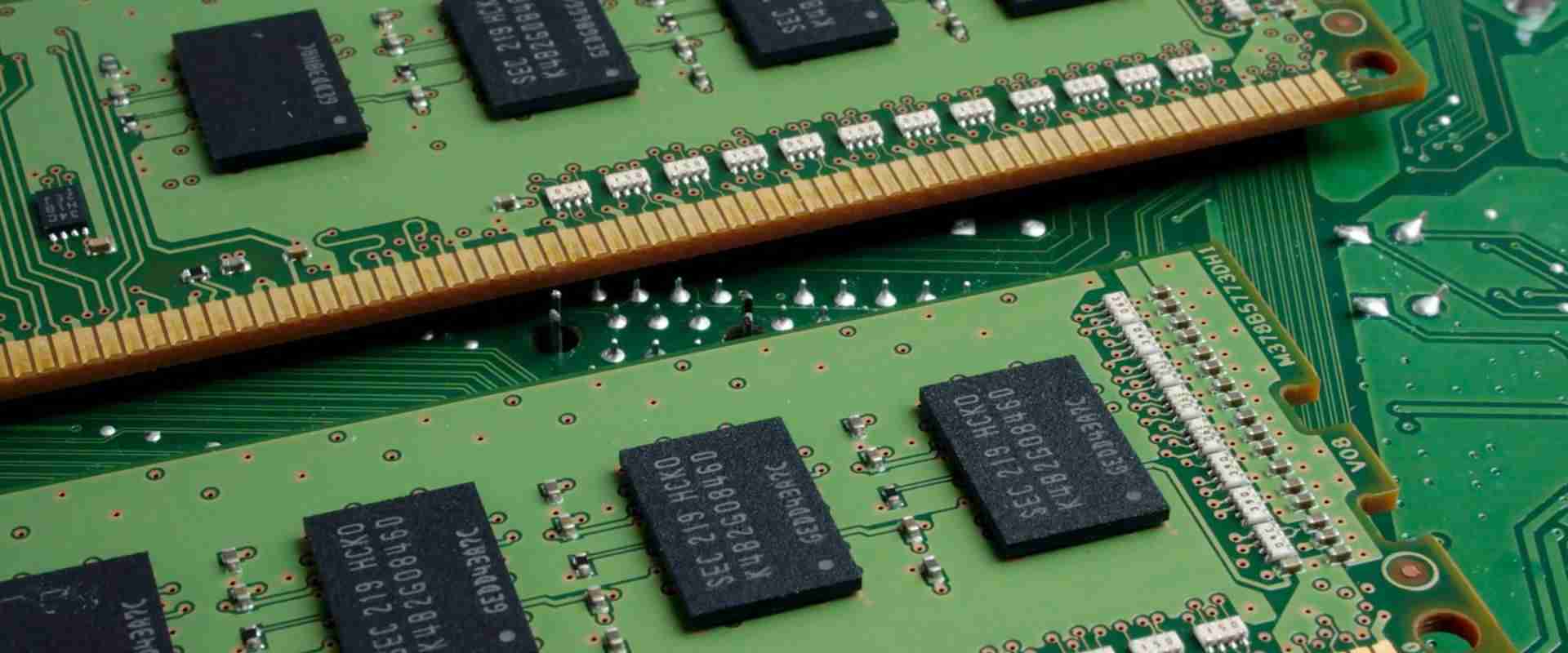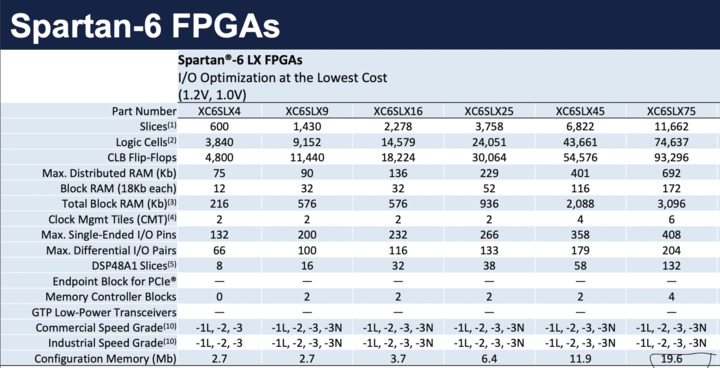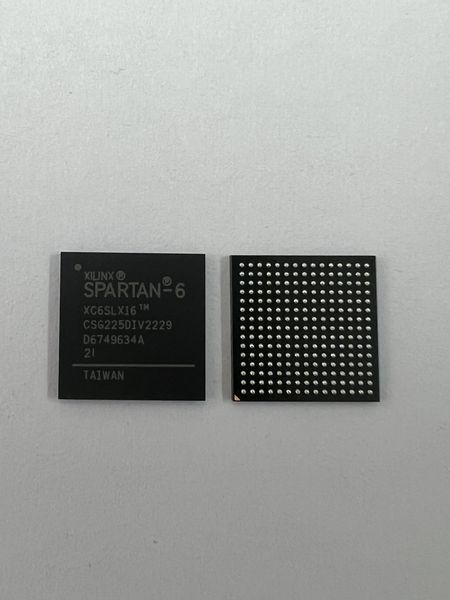When comparing FPGAs like the XC6SLX16 and XC6SLX25 from Xilinx, several key factors come into play that can influence their suitability for particular applications. Here's a comparison between the XC6SLX16 and XC6SLX25 FPGAs:
XC6SLX16 FPGA:
- Logic Cells: The XC6SLX16 FPGA offers fewer logic cells compared to the XC6SLX25, which can impact the complexity and size of designs that can be implemented.
- Performance: Generally, the XC6SLX16 may have slightly lower performance metrics than the XC6SLX25 due to its lesser resources.
- I/Os: The number of available I/O pins may be lower in the XC6SLX16, limiting the interfacing capabilities compared to the XC6SLX25.
- Cost: The XC6SLX16 may be more cost-effective than the XC6SLX25, making it a preferred choice for applications with budget constraints.
- Power Consumption: Typically, lower logic cell count may result in lower power consumption for the XC6SLX16 compared to the XC6SLX25.
XC6SLX25 FPGA:
- Logic Cells: The XC6SLX25 FPGA offers more logic cells, providing additional resources for complex designs over the XC6SLX16.
- Performance: With more logic cells, the XC6SLX25 can handle larger and more complex designs, potentially offering higher performance.
- I/Os: The XC6SLX25 likely provides more I/O pins, allowing for more extensive interfacing options and connectivity features.
- Cost: Due to its larger capacity and potential for higher performance, the XC6SLX25 may be priced higher than the XC6SLX16.
- Power Consumption: The increased logic cell count and potential for higher performance may lead to slightly higher power consumption compared to the XC6SLX16.
Application Considerations:
- XC6SLX16: Suitable for applications with smaller logic requirements, cost-sensitive projects, and designs where power consumption needs to be minimized.
- XC6SLX25: Ideal for applications demanding higher performance, larger logic capacity, extensive interfacing capabilities, and where budget constraints allow for a higher-priced FPGA.
Project Selection:
- XC6SLX16: Choose this FPGA for simpler designs, cost-effective solutions, and projects with modest logic and I/O requirements.
- XC6SLX25: Opt for this FPGA when working on complex designs, performance-critical applications, projects requiring a significant number of logic cells and I/O pins.
Before selecting between the XC6SLX16 and XC6SLX25 FPGAs, consider your project requirements, including logic capacity, performance needs, I/O requirements, budget constraints, and power consumption constraints. This evaluation will help you choose the FPGA that best aligns with your application's specific demands.

XC6SLX16 vs XC6SLX25: Specifications
When comparing the Xilinx XC6SLX16 and XC6SLX25 FPGAs, it's essential to look at their specifications to understand their capabilities and differences. Here are the key specifications for these two FPGA models:
Xilinx XC6SLX16 FPGA:
- Logic Cells: 14,579 Logic Cells
- Slices: 4,100 Slices
- Memory:
- Block RAM: 72 Kb (18 blocks)
- Distributed RAM: 140 Kb
- DSP Slices: 32
- Clock Management Tiles: 4
- I/Os: 105 I/O Pins
- Maximum User I/Os: 105
- Operating Voltage: 1.14V to 1.26V
- Package: Available in various packages like FGG484, FG484, and CS484
Xilinx XC6SLX25 FPGA:
- Logic Cells: 23,360 Logic Cells
- Slices: 6,520 Slices
- Memory:
- Block RAM: 132 Kb (33 blocks)
- Distributed RAM: 283 Kb
- DSP Slices: 54
- Clock Management Tiles: 4
- I/Os: 177 I/O Pins
- Maximum User I/Os: 154 (Some I/Os are dedicated)
- Operating Voltage: 1.14V to 1.26V
- Package: Available in various packages like CSG324, FG324, and FGG324
Comparison:
- The XC6SLX25 FPGA has significantly more logic cells, slices, and memory resources compared to the XC6SLX16 FPGA.
- The XC6SLX25 FPGA offers a higher number of DSP slices, block RAM resources, and distributed RAM compared to the XC6SLX16 FPGA.
- The XC6SLX25 FPGA supports more I/O pins, with a maximum of 154 user I/Os compared to 105 user I/Os in the XC6SLX16 FPGA.
- Both FPGAs operate within the same voltage range and are available in various package options to suit different design requirements.
Application:
- XC6SLX16: Suitable for smaller-scale applications, projects with moderate logic and memory requirements, and designs with fewer I/O interfaces.
- XC6SLX25: Ideal for more complex designs, projects requiring higher logic capacity, extensive memory resources, and more I/O interfaces.
These specifications highlight the differences in capacity, resource availability, and I/O capabilities between the Xilinx XC6SLX16 and XC6SLX25 FPGAs, enabling you to select the FPGA that best suits your project requirements.

XC6SLX16 vs XC6SLX25: Features & Benefits
When comparing the Xilinx XC6SLX16 and XC6SLX25 FPGAs, each model offers specific features and benefits suited to different applications. Here is a breakdown of the features and benefits of these two FPGA models:
Xilinx XC6SLX16 FPGA:
-
Features:
- Logic Capacity: Offers 14,579 logic cells, suitable for smaller-scale designs and applications.
- Memory Resources: Includes 72 Kb of block RAM and 140 Kb of distributed RAM.
- DSP Slices: Provides 32 DSP slices for signal processing applications.
- Clock Management: Equipped with 4 clock management tiles for precise timing control.
- I/Os: Features 105 user I/O pins for interfacing with external components.
- Operating Voltage: Operates within a voltage range of 1.14V to 1.26V.
- Package Options: Available in various packages such as FGG484, FG484, and CS484.
-
Benefits:
- Cost-Effective: Suited for cost-sensitive projects due to its lower logic capacity and resource requirements.
- Power Efficiency: Lower power consumption compared to larger FPGAs, making it suitable for power-sensitive applications.
- Ideal for Small Designs: Perfect for applications with modest logic requirements and fewer I/O interfaces.
Xilinx XC6SLX25 FPGA:
-
Features:
- Enhanced Logic Capacity: Offers 23,360 logic cells for more extensive and complex designs.
- Memory Resources: Includes 132 Kb of block RAM and 283 Kb of distributed RAM for data storage and processing.
- DSP Slices: Provides 54 DSP slices for demanding signal processing tasks.
- I/Os: Features 177 user I/O pins, allowing for more extensive interfacing capabilities.
- Clock Management: Includes 4 clock management tiles for precise clock distribution and timing control.
- Operating Voltage: Operates within a voltage range of 1.14V to 1.26V.
- Package Options: Available in various packages like CSG324, FG324, and FGG324.
-
Benefits:
- High Performance: Suitable for applications requiring higher logic capacity, memory resources, and processing power.
- Versatility: Offers more I/O options for interfacing with a variety of external devices and components.
- Complex Designs: Ideal for complex designs that demand a higher level of resources and performance capabilities.
Summary:
- XC6SLX16: Cost-effective, power-efficient, and ideal for modest-sized designs with lower resource requirements.
- XC6SLX25: Offers enhanced logic capacity, memory resources, and performance capabilities for more complex and demanding applications.
Select the FPGA model based on your project's specific requirements, budget constraints, performance needs, and design complexity to ensure optimal functionality and efficiency in your application.

XC6SLX16 vs XC6SLX25: Equivalents
When comparing the Xilinx XC6SLX16 and XC6SLX25 FPGAs, and looking for equivalents in terms of performance and capabilities from other manufacturers, it's important to consider devices that offer similar logic capacity, memory resources, I/O capabilities, and overall features. While exact equivalents may not exist due to variations in architectures and features across FPGA families, you can look for FPGAs from other manufacturers that are in a similar range in terms of specifications. Here are some potential equivalents:
Possible Equivalents for XC6SLX16:
-
Altera/Intel Cyclone IV EP4CE6:
- Logic Capacity: Similar level of logic cells suitable for smaller designs.
- Memory: Comparable memory resources and I/O capabilities for entry-level applications.
-
Lattice Semiconductor iCE40 UltraPlus:
- While not directly comparable in terms of size, it targets low-power and small-footprint applications, suitable for certain niche requirements.
-
Microchip/Atmel ATF150X:
- Offers low to mid-range logic capacities and features, which might be suitable for relatively simpler designs.
Possible Equivalents for XC6SLX25:
-
Altera/Intel Cyclone IV EP4CE22:
- Features a higher logic capacity and memory resources, similar to the XC6SLX25, suitable for more complex designs.
-
Lattice Semiconductor ECP5-12K:
- Provides enhanced logic capacity and features for demanding applications, comparable to the XC6SLX25.
-
Microchip/Atmel ATF1504ASV:
- While not a direct equivalent, it offers comparable resources for mid-range FPGA applications.
Considerations:
- When looking for equivalents from other manufacturers, it's essential to review the datasheets and technical specifications to ensure compatibility with your design requirements.
- Each FPGA manufacturer has its own architecture, tools, and ecosystem, so transitioning between different brands may require adjustments to your design flow.
- The equivalency of FPGAs often depends on specific project requirements, including logic capacity, memory resources, I/O capabilities, power consumption, and cost considerations.
While these suggestions offer approximate equivalents in terms of logic capacity and features, it's advisable to consult with FPGA vendors and review datasheets for detailed comparisons to identify the best alternative for your specific application needs.




